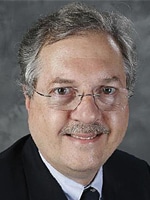Meredith W. Salisbury
August 2020—As the need for COVID-19 testing grows well beyond that for hospital patients, clinical laboratories in mid-summer were again overwhelmed by demand while at the same time bracing for flu season.
That was the gist of a July 10 webinar that brought together Gyorgy Abel, MD, PhD, medical director of clinical chemistry, molecular diagnostics, immunology, and point-of-care testing at Lahey Hospital and Medical Center, Burlington, Mass.; Bob McGonnagle, CAP TODAY publisher; and moderator Steve Beuchaw, director of life science and medical device research, Wolfe Research.
Demand for COVID-19 testing appeared to be nearly insatiable as several states were breaking records for daily case numbers and death rates were beginning to climb after two months of decline. “The headline for the last couple of weeks would be the enormous demand for molecular PCR testing for the definitive diagnosis of COVID,” McGonnagle said. “At the moment it’s really overwhelming laboratory capacity.”

Dr. Abel
Adding to the difficulty is that the testing capacity that’s needed is “a moving target,” Dr. Abel said. As testing expands to new populations—asymptomatic patients, college students, entire workforces—even recent capacity increases have proved insufficient. Manufacturers are responding by releasing more tests for SARS-CoV-2 on a broad range of diagnostic platforms, and new large laboratories are being built to scale up capacity quickly.
Also increasing the need for COVID-19 testing is the return of elective surgeries. Given how many procedures were deferred during lockdowns or by patients too worried about the pandemic to seek care, a resumption could push the demand further for SARS-CoV-2 testing. McGonnagle and Dr. Abel agree that clinical labs in the U.S. would have to increase capacity to at least 6 million tests per week to meet acute care needs.
Beuchaw calls test manufacturers’ response to the pandemic “extraordinary,” and he wonders how much more it is possible for them to continue increasing supplies of tests and reagents. “They have every incentive to fulfill that need,” McGonnagle said, noting that current bottlenecks were caused not only by instrument or kit shortages but also by limitations in lab resources.
Most clinical laboratories have been successful in redirecting or hiring medical technologists to shift resources to COVID-19 testing, Dr. Abel said. And labs addressed test supply problems largely by implementing SARS-CoV-2 testing on more than one platform. Labs need to use all options, he said, even manual testing, to increase capacity.
The varying capabilities of clinical laboratories present a big challenge, McGonnagle said. “The labs that can do COVID PCR testing across the United States number probably no more than 1,000,” and test demand has largely flowed upward from system laboratories to regional, national, reference, and large commercial labs. “All are dealing with test demand that has strained the system and hugely lengthened turnaround times,” he said.
 CAP TODAY Pathology/Laboratory Medicine/Laboratory Management
CAP TODAY Pathology/Laboratory Medicine/Laboratory Management
